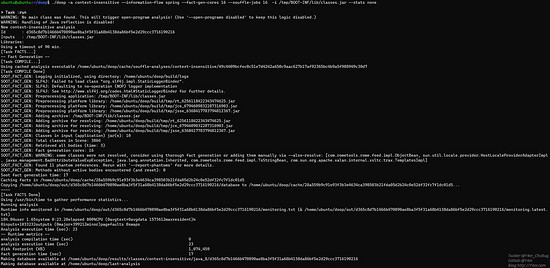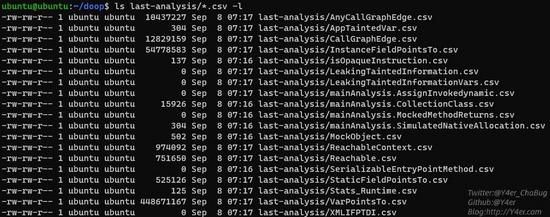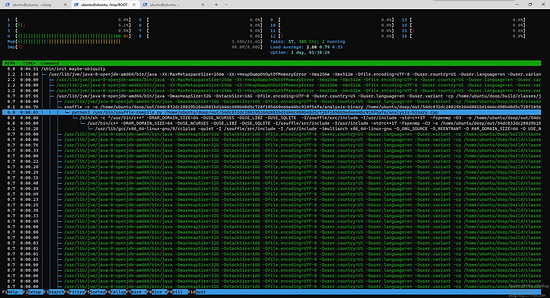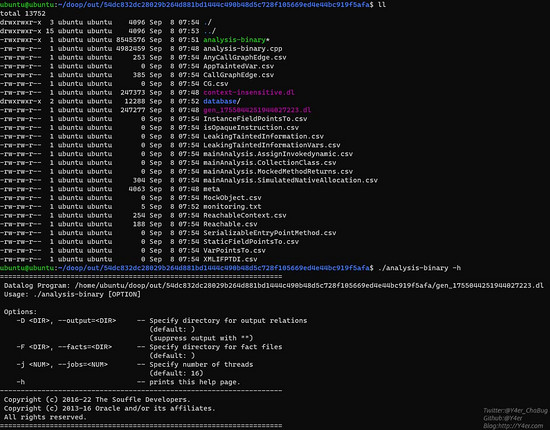doop仓库是一个gradle项目, ./doop 其实就是一个bash去调用gradle命令
#!/usr/bin/env bash
ARGS=""
while [ "$1" != "" ]; do
case "$1" in
# Quote arguments with spaces.
*\ * )
ARGS="${ARGS} '$1'"
;;
*)
ARGS="${ARGS} $1"
;;
esac
shift
done
# Export number of terminal columns for help display.
if command -v 'tput' &> /dev/null
then
export COLUMNS=`tput cols`
fi
eval "./gradlew :run -Pargs=\"$ARGS\""
还提供了一个 ./doopOffline ,就是离线模式的doop。通常在每次调用Doop时,底层构建系统都会检查所有依赖库的更新版本。有时可能需要在离线模式下调用doop。为此目的有一个替代脚本。
#!/bin/bash eval './gradlew :run -Pargs="'$@'" --offline'
其实就是gradle加了一个offline参数
Doop 执行流程大致可以分为几步:
- 使用soot生成jimple文件
- 使用
--generate-jimple参数可以输出jimple文件,在output/$(uuid)/database/jimple文件夹下 - 将jimple文件转换为datalog引擎的输入事实(.facts)
- 使用souffle引擎执行选定的分析,将关系输出为
.csv,即分析结果
以长城杯b4bycoffee为例,解压springboot项目,将class文件打包为jar包
unzip b4bycoffee.jar cd BOOT-INF/classes jar -cvf classes.jar *
然后运行
./doop -a context-insensitive --information-flow spring --fact-gen-cores 16 --souffle-jobs 16 -i /tmp/BOOT-INF/lib/classes.jar --stats none
解释一下各个参数
-a context-insensitive --information-flow spring --fact-gen-cores 16 --souffle-jobs 16 -i /tmp/BOOT-INF/lib/classes.jar --stats none
如果是第一次执行会比较慢,因为他会去 http://centauri.di.uoa.gr:8081/ 拉一些jar包,等着就行了,第二次就快了。

构建完之后可见整个构建过程分为几部分
out/uuid/database

分析输出的结果如图
ubuntu@ubuntu:~/doop$ cat last-analysis/MockObject.csv javax.servlet.http.HttpServletRequest::MockObject javax.servlet.http.HttpServletRequest javax.servlet.http.HttpServletResponse::MockObject javax.servlet.http.HttpServletResponse com.example.b4bycoffee.controller.indexController::MockObject com.example.b4bycoffee.controller.indexController com.example.b4bycoffee.controller.coffeeController::MockObject com.example.b4bycoffee.controller.coffeeController com.example.b4bycoffee.model.CoffeeRequest::MockObject com.example.b4bycoffee.model.CoffeeRequest
可见spring的controller会被自动进行污点分析。

除去 --information-flow 指定为spring以外还支持一些其他的比如webapps javaee项目,这里不再演示了。
添加自己的规则
doop的规则是基础规则,只给你了脚手架,针对我们的实际应用我们不得不写一些自定义规则,比如我们想要调用图,那么可以将如下规则保存为my.dl
.decl CG(?caller:Method, ?callee:Method) CG(?caller, ?callee) :- mainAnalysis.AnyCallGraphEdge(?invocation, ?callee), Instruction_Method(?invocation, ?caller). .output CG
然后加上参数 --extra-logic my.dl 重新构建,查看last-analysis下的CG.csv即可。
另一种自定义规则的方式
加参数 --extra-logic 仍然会很慢,会更新依赖包、重新编译、生成facts等固定步骤,有没有更快的方式?
在doop分析的时候可见是用gcc编译成二进制文件来分析

这个二进制文件是souffle编译完的可执行文件。

可以直接运行这个可执行文件会按照之前的规则重新输出结果,规则文件是 gen_xxx.dl

我们写的my.dl被追加到最后面去执行了。
那么我们想要改自定义的规则可以直接编辑这个 gen_xx.dl ,在最后面追加即可。然后用souffle去运行,毕竟facts事实文件都有了。
souffle -F database/ gen_1755044251944027223.dl -j32
这里提到bytecodedl是把doop的几部分拆出来做了。用soot-facts-generator生成facts,编写规则之后直接用souffle进行查询。
而doop的好处就是内置的规则比bytecodedl多。

缺点很明显就是慢,每次查询都需要下依赖并重新生成facts。
官方也提到了可以生成facts之后用souffle运行自定义规则,我直接复制过来。
在文件 temp.dl 中放入代码:
#!java .decl Var_DeclaringMethod(v: symbol, m: symbol) .input Var_DeclaringMethod(IO="file", filename="Var-DeclaringMethod.facts", delimiter="\t") .decl VarPointsTo(c1: symbol, h: symbol, c2: symbol, v: symbol) .input VarPointsTo(IO="file", filename="VarPointsTo.csv", delimiter="\t") .decl Temp(v: symbol, h: symbol) Temp(v, h) :- VarPointsTo(_, h, _, v), Var_DeclaringMethod(v, "<Example: void test(int)>"). .output Temp
复制 Var-DeclaringMethod.facts,使它们与输出关系 VarPointsTo 位于同一目录中(替换$id为您的分析 ID):
#!bash $ cp out/$id/facts/Var-DeclaringMethod.facts out/$id/database/
运行查询并查看其结果:
#!bash $ souffle -F out/$id/database/ temp.dl $ cat Temp.csv <Example: void test(int)>/@this <Example: void main(java.lang.String[])>/new Example/0 <Example: void test(int)>/l0#_0 <Example: void main(java.lang.String[])>/new Example/0 <Example: void test(int)>/l3#_32 <Example: void test(int)>/new Cat/1 <Example: void test(int)>/l4#_33 <Example: void test(int)>/new Cat/2 <Example: void test(int)>/$stack5 <Example: void test(int)>/new Dog/0 <Example: void test(int)>/$stack6 <Example: void test(int)>/new Cat/1 <Example: void test(int)>/$stack7 <Example: void test(int)>/new Cat/2 <Example: void test(int)>/$stack8 <Example: void test(int)>/new Cat/0 <Example: void test(int)>/l2#_26 <Example: void test(int)>/new Cat/0 <Example: void test(int)>/l2_$$A_1#_28 <Example: void test(int)>/new Dog/0 <Example: void test(int)>/l2_$$A_2#_29 <Example: void test(int)>/new Cat/0 <Example: void test(int)>/l2_$$A_2#_29 <Example: void test(int)>/new Dog/0
这种方式需要你写import facts的规则,比较麻烦。bytecodedl就是这样。
可能会碰到的报错
soot生成facts事实的时候可能会报oom异常,这是因为内存给小了,修改build.gradle中
def factGenXmx='32G' def factGenStack='16G'
给大一点就行了。
文末
其实doop最精华的应该是他的dl规则,我再看明白一点再写文章把。
说是最牛逼的指针分析框架,但实际学习的时候文档不全、资料太少、莫名其妙的报错等各种原因导致学习门槛太高了。
对实际挖洞而言,具体怎么用得再学一学再写,个人倾向于像bytecodedl那样拆出来改一改,加上危险函数sink规则,配合doop原有的spring、webapp的source,输出一条准确的污点分析过后的路径图是最好的。